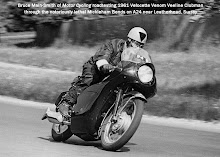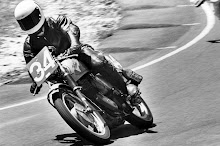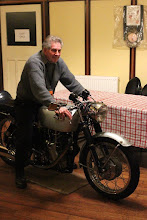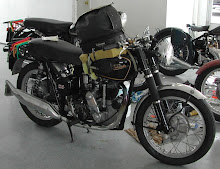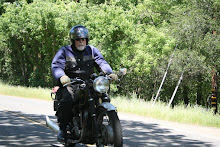Wednesday at
 Flint Indian Sales as hundreds of motorcyclists and dealers turned up for an estate auction at the N. Saginaw Street business. The event, billed as one of the largest auctions of rare and antique motorcycle parts in the U.S., included the sale of a 1941 four-cylinder Indian motorcycle, along with many other old motorcycles, some still in their original shipping crates. Herbert L. Kunze, who owned the combination bicycle/motorcycle dealership for decades, died Feb.26. His father opened the business in the 1920s.” Around Friday before the auction I received a fax from a UK supplier…” "Was I going to the Flint Auction?”..
Flint Indian Sales as hundreds of motorcyclists and dealers turned up for an estate auction at the N. Saginaw Street business. The event, billed as one of the largest auctions of rare and antique motorcycle parts in the U.S., included the sale of a 1941 four-cylinder Indian motorcycle, along with many other old motorcycles, some still in their original shipping crates. Herbert L. Kunze, who owned the combination bicycle/motorcycle dealership for decades, died Feb.26. His father opened the business in the 1920s.” Around Friday before the auction I received a fax from a UK supplier…” "Was I going to the Flint Auction?”.. 
"What auction "I faxed back.
By the Sunday night Sydney time I had a good idea there were lots of items for sale, including instruments and a telephone call to Bob Schanz, prop. of Domiracer asking if he’d bid on some items for me elicited the reply that he was there to buy and I could in turn later buy off him…!
By late Monday I’d secured a flight ticket from Sydney to LA, on to Chicago and then to Lansing and a rental car booked and arrangements made with my bank.
Tuesday on the way to the airport I called into the school my wife taught at and said "see you in a week"… Flying into Chicago the weather looked ominous and a further delay landing at Lansing due to Air Force One being on the ground as the President was in town for the great debates in Michigan State University, meant I was real late into a motel.
The quietness the next morning turned out to be from a big dump of snow during the night & I was not prepared from this coming from Australia.
The auction site was an eye-opener…two large buildings, a shop and warehouse, were like a maze, which proved to be full of motorcycles…over 200 were on offer of which 60 were new & many still in their crates and parts.. man I’ve never seen so many.
Inventories of Matchless/AJS parts, Norton, Indian, Moto Guzzi, Greeves, Zundapp, Sachs parts, shelves of Smiths, Lucas ( I’m pretty sure there were 2300 sets of ignition points for example…), Amal parts, bags of Metzeler tyres…the list went on.
Rooms with used partly dismantled motorcycles and parts.
The next surprise was having to pay US$500 to get into the auction…refunded when you bought something or later on (?).
 …..Some 200 bidders registered, eager for the over 800 lots listed and the motorcycles mentioned..
…..Some 200 bidders registered, eager for the over 800 lots listed and the motorcycles mentioned..Major players were British Only from Detroit and Domiracer Distributors Inc, from Cincinnati, with some UK dealers, myself from Australia and many smaller US dealers and individuals.
Many of the lots were large in quantity and this annoyed some smaller buyers…the AJS/Matchless inventory was in seven lots, actually auctioned off as one large lot…the auctioneer, Jerry Wood commented… ”Whoever buys this will be the world’s largest Matchless distributor..”…it went for US$110,000 to Domiracer.
There was a room called aptly “The Indian Room”… heaps of pre-war Indian Parts, including new crankcases etc for singles and the four cylinder motorcycles…. lots of bidding activity there. The three damaged Corbin speedos I was interested in made US$1300, my proposed max. bid of US$1000 was left in the dust. There were six new Norton Commandos, all but one had been riffled for some parts to sell in the past and were variously incomplete. The one complete bike
 went for US$9750…a BIG price then.
went for US$9750…a BIG price then.AJS Motorcycles from the UK were over to purchase the stocks of later two stroke AJS Stormer motocrossers ( thirteen new ones, seven still in crates, for US$26,500) and inventory US$15,000 . Zundapp inventory US$18,000;Smiths inventory US$22,000;Lucas inventory US$43,000; Amal inventory US$21,000; Ducati inventory US$21,000; Greeves inventory US$1000; Norton inventory US$57,000; Moto Guzzi inventory US$28,000;Ducati factory tools US$2,100; Seven new Greeves motocrossers US$13,700…the list goes on….
Who was Flint Indian Sales….?
Seems Herb Kunze, the owner who had died in the Feb. before was a quiet man and operated the Flint dealership that had been in operation since 1928, being started by Herb’s father, “Speed” Kunze.
Herb took over in the late 1960s. When Indian Motorcycles went out of business in the early 1950s the shop turned to other machines such as Norton, Matchless, Zundapp & Penton, but Kunze c
 hose to keep the name Flint Indian Sales.
hose to keep the name Flint Indian Sales.Herb was well known for sponsoring champion enduro riders. He bought the store from his father as mentioned, then bought the entire building next door and sold Schwinn bicycles from it.
He remained in the buildings even while most of the North Saginaw Street area businesses around him pulled out.
So did I justify the time and expense of the trip, which started out as a business venture?
The answer has to be yes…I’d never been to anything like this before and I’d been to my share of auctions…
I spent some US$500 of a few items, made more friends and acquaintances, but the Smiths inventory for which I’d actually travelled over for, ended up with a twist….
Remember I said before that I’d asked Domiracer to buy for me?…well soon after I arrived I met up with Bob Schanz…”Your here “ he exclaimed…. “You bet “ I an
 swered. Then we moved on apart amongst the many
swered. Then we moved on apart amongst the manyitems to view…but about 30 lots before the Smiths stuff came up, his RH man, Jonathan White came up to me, pulled me aside and in a quiet voice said…”Just what are you after?”…”I’ll settle for half” I replied ( fingers crossed)…. “Deal done…don’t bid against us…”. I didn’t and some months later we divvied up the Smiths instrument proceeds.
A brief visit to British Only in the few days left saw me homeward bound and looking back now, with a warm feeling inside to have been involved in this fascinating part of Motorcycle history.
Photos above show;- The front page of the auction catalogue; New 1950s Matchless frames wrapped in hessian sacking strips from the factory; Shelf of Dellorto carbs and parts;Boxes of new Norton Commando cylinders;Shelves of Smiths instruments;A shelf from the "Indian Room" with new 4 cyl.crankcases etc.
Left click on photos to enlarge.







